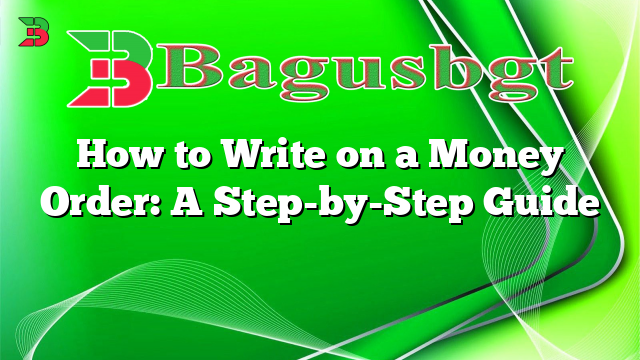Hello and welcome to our comprehensive guide on how to write on a money order. In this article, we will provide you with detailed instructions and useful tips to ensure that you fill out your money order correctly. Whether you are sending money domestically or internationally, it is crucial to understand the proper way to complete a money order form. Let’s dive right in!
1. Gather the necessary information
Before you start filling out the money order, make sure you have all the required information. This includes the recipient’s name, address, and the exact amount you wish to send. Additionally, ensure that you have enough funds to cover the money order and any associated fees.
2. Write your personal information
On the “Purchaser” or “From” line, write your full name, address, and phone number. Providing accurate personal information is essential for the recipient and the issuing institution to contact you if necessary.
3. Fill in the recipient’s information
On the “Pay to the Order of” line, write the recipient’s full name. Double-check the spelling to avoid any complications. If the money order is being sent to a business, include the company name as well. Below the name, write the recipient’s complete address.
4. Specify the payment amount
In the box labeled “Payment for,” write the purpose of the payment. For example, if you are paying rent, write “Rent payment” or if you are making a donation, specify the cause. This step helps the recipient identify the purpose of the money order.
5. Write the payment amount numerically
In the box next to the dollar sign ($), write the payment amount numerically. Start with the dollar amount, followed by a decimal point and the cents. Make sure to write clearly and avoid any alterations or corrections.
6. Spell out the payment amount in words
On the line below the recipient’s information, write out the payment amount in words. Start with the dollar amount, followed by “and” and then the cents written as a fraction. For example, if the payment amount is $100.75, write “One hundred dollars and 75/100.”
7. Sign the money order
At the bottom right corner of the money order, you will find a designated space for your signature. Sign your name exactly as it appears on the “Purchaser” or “From” line. Avoid any additional marks or writings in this area.
8. Detach the receipt
After completing all the necessary fields, tear off the receipt portion of the money order along the perforated edge. This serves as your proof of payment and includes essential details such as the serial number and date of issue.
9. Keep the receipt in a safe place
It is crucial to retain the receipt in case any issues or inquiries arise regarding the money order. Store it in a safe and easily accessible location until you are certain that the transaction has been successfully completed.
10. Send or deliver the money order
Depending on your preference and the recipient’s location, you can either mail the money order or deliver it in person. Ensure that it reaches the intended recipient securely and within the required timeframe.
Money orders offer several advantages over other payment methods. Firstly, they provide a safe and secure way to send money, as they are less susceptible to theft or fraud compared to cash. Money orders also offer a traceable record of payment, allowing both the sender and recipient to track the transaction if necessary.
However, it is essential to consider the potential disadvantages of using money orders. One drawback is the cost associated with purchasing money orders, as financial institutions often charge fees for their services. Additionally, money orders may not be suitable for large transactions, as they typically have a maximum limit that can be sent.
Despite these limitations, money orders remain a reliable and widely accepted form of payment, particularly in situations where personal checks or electronic transfers may not be feasible.
While money orders have their benefits, it is worth exploring alternative methods for sending money, depending on your specific needs. Here are a few popular alternatives:
1. Bank Transfers
Bank transfers allow you to send money electronically from your bank account to another individual’s account. This method is convenient and often offers faster processing times compared to money orders.
2. Online Payment Services
Services such as PayPal, Venmo, and Cash App enable you to send money instantly to other users through their online platforms or mobile applications. These services are widely used and offer additional features like payment tracking and splitting expenses.
3. Wire Transfers
Wire transfers are a secure way of sending money directly from one bank account to another. While they are convenient for larger transactions, they may involve higher fees compared to other methods.
| Question | Answer |
|---|---|
| Can I use a money order for international payments? | Yes, money orders can be used for international payments. However, it is essential to check with the issuing institution regarding their specific policies and any additional requirements. |
| How long does it take for a money order to clear? | The clearing time for a money order may vary depending on the financial institution and the recipient’s location. Typically, it takes a few days for the payment to be processed. |
| What should I do if my money order is lost or stolen? | If your money order is lost or stolen, you should contact the issuer immediately. They will provide guidance on how to proceed and may be able to issue a replacement or refund. |
| Are there any transaction limits for money orders? | Yes, most money orders have a maximum limit that can be sent. It is important to check with the issuing institution regarding their specific limits. |
In Conclusion
Writing on a money order correctly is crucial to ensure that your payment reaches the intended recipient without any issues. By following the step-by-step guide provided in this article, you can confidently fill out a money order and send it securely. Remember to gather all the necessary information, write clearly and accurately, and retain the receipt for your records. If money orders are not suitable for your needs, explore alternative methods such as bank transfers or online payment services. By understanding the process and exploring different options, you can choose the most convenient and secure way to send money.
 Bagus Banget Collection of the latest information from various reliable sources
Bagus Banget Collection of the latest information from various reliable sources





